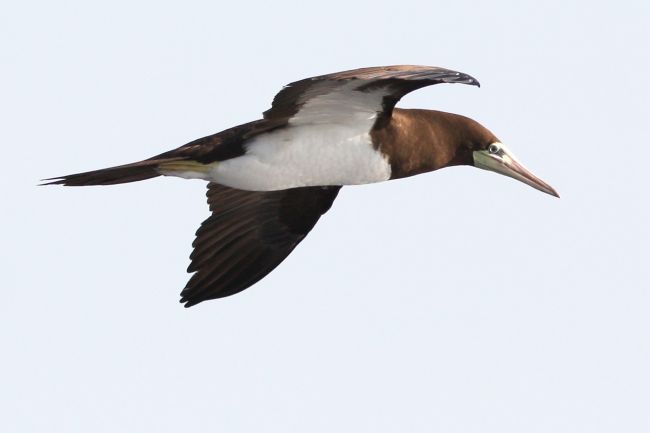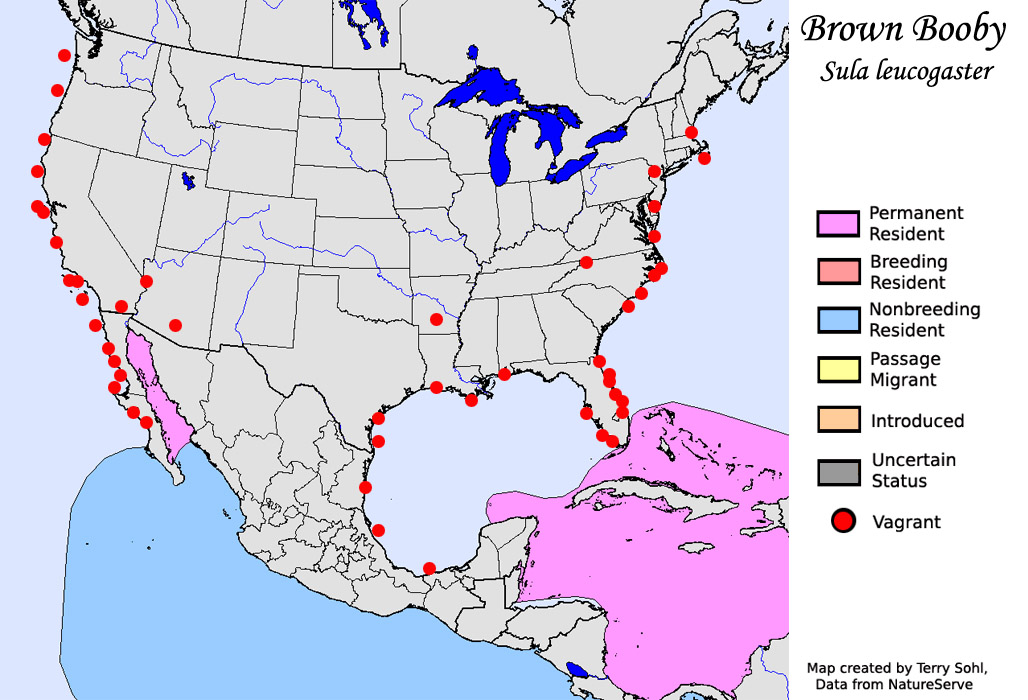
This message conjures up different images to different people. My immediate response was "where is Long Beach?" I was so blindsided by the announcement that I had forgotten Long Beach, one of my favourite birding destinations, was located next to Cape Race on the southeast corner of the Avalon Peninsula.
Instantly arrangements were made for a group trip in Ken's car. It is a two-hour drive to Long Beach from St. John's. There were only two hours left in the day before sunset. John Wells, Chris Brown and I all knew Ken can beat any setting sun when the right bird is the target. A brown booby more than qualified for the exhilarating ride down the Southern Shore highway.
A brown booby is a seabird related to the Newfoundland gannet. It is a little smaller than a gannet but is still bigger than any gull. On stiff wings it flies and glides over tropical oceans, diving into the water for flying fish and squid. The brown booby is widespread in the Caribbean and is regular up to the Florida Keys.
Most historic records of brown boobies north of the Florida Keys are hurricane waifs. However, about three years ago brown boobies started doing odd things. They started appearing in the northeast United States without an obvious explanation. These were not storm driven birds, but individuals flying north of their own free will. One even reached the Bay of Fundy in New Brunswick. And the first for the province of Newfoundland and Labrador landed on a tour boat just off St. Anthony.
The next year a brown booby was photographed after it landed on the back of a ship on the eastern Grand Banks. Photos of another one on a ship from somewhere on the southern Grand Banks surfaced. Then early in July this year one was photographed on a ship about 400 kilometres south of Trepassey.
It was safe to say that brown booby was on the radar of the rarity-seeking birders. And they all wished they could have been in Richard Thomas's shoes when he and British Columbian visitors Bob and Jan Carroll spotted an odd bird sitting on a point off the eastern end of Long Beach. It was a long way off but when viewed through a spotting scope, the unmistakable image of a long billed, chocolate brown bird with a sharply demarcated white belly revealed it to be the almost unimaginable brown booby.
The threesome walked for 10 minutes or so to get closer to the bird. Careful not to get too close and flush the bird they stopped 80 metres back from it. From here they admired their incredible find and took a few photographs through the spotting scope. The photos are fuzzy but they show beyond doubt it was an adult brown booby, the first on land in Newfoundland.
Ken's bird-chasing machine arrived on the scene before sunset, but not before the booby had departed. We searched around for 45 minutes until it was too dark to see. There was lots of seabird action. Hundreds of shearwaters, kittiwakes, gannets and gulls meant there was caplin around. It looked good that the booby would hang around.
Early the next morning John Wells and I were back at the point east of Long Beach where the brown booby had been perched just the evening before. There were a few cormorants and gulls resting comfortably on the rocks, but no brown booby.




Reader Comments
to our Newsletter